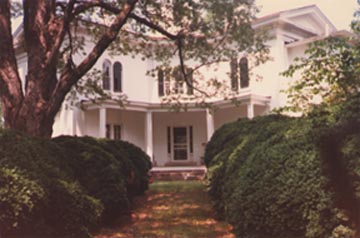
The Cooleemee Plantation is located in Davie County on the Yadkin River. William Giles, a speculator, purchased the property and sold it to Zachariah Haden, who subsequently deeded it to Richmond Pearson, an in-law. In 1804 Pearson's son, Gen. Jesse Pearson, was given the land as a wedding present. He gave it the name Cooleemee, apparently the name of an American Indian village in Alabama, where Pearson served in the Creek War. The name is believed to mean, "place where the white oaks grow."
In 1817 Maj. Peter Hairston bought the 2,300-acre plantation from Pearson. The major's grandson, Peter Wilson Hairston, inherited the plantation in 1832. By 1860 he had increased Cooleemee to 4,200 acres. The plantation was worked by 300 enslaved people. who raised tobacco, corn, cotton, and hogs. Hairston only ever sold one of his enslaved people, and only one enslaved person was ever documented to have fled the plantation. One notable person among Cooleemee's enslaved workers was his coachman John Goolsby. Goolsby described himself as the descendant of an African king, and was noted to have a "dignified manner, sharp mind and unfailing loyalty." When Peter W. Hairston left to serve the Confederacy, Goolsby was taken with him to serve the Confederacy as well.
The plantation home was built from 1853 to 1855 and is in the shape of a Greek cross. More than 300,000 bricks made on the plantation were used in its construction. Inside is a winding stairway, largely self-supporting. In 1850, Godey's Ladies Book carried the house plan and a picture of the proposed building. In 1854 J. E. B. Stuart visited Cooleemee to call on his sister Columbia, wife of Peter W. Hairston and mistress of the plantation. Columbia died in 1857 while giving birth to a daughter. Peter Hairston married again in 1859, to Fanny Caldwell of Salisbury. When the Civil War broke out, Hairston volunteered as an aide for Stuart, who had risen to the rank of general. Later he served as an aide for Gen. Jubal Early in the Shenandoah Valley near the war's end.
After the war, the Hairstons moved to Baltimore, Md. In 1886 Peter died and the family returned to Cooleemee. The plantation remained in the Hairston family throughout the twentieth century. Descendants of the enslaved people at Cooleemee founded the Hairston Clan, holding their first reunion in 1974. In August 1979, when the U.S. Department of the Interior designated Cooleemee as a National Historic Landmark, Squire Hairston of the Hairston Clan delivered the principle address. A few other notables in the group included Jester Hairston, actor, composer, and musician; Guy E. Hairston Jr., U.S. Air Force general; William Hairston, playwright; Nelson G. Hairston, animal ecologist and Kenan Professor at the University of North Carolina at Chapel Hill; and Happy Hairston, former member of the Harlem Globetrotters basketball team.